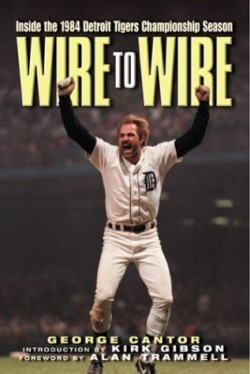Inside the 1984 Detroit Tigers Championship Season
It was twenty years ago today (or pretty close to it) that Sparky Anderson taught the Detroit Tigers how to be winners.
Unlike the Tigers of 2003, who resembled the 1962 Mets in terms of inefficiency, the 1984 team had one of the best starts to a season in the annals of pro sports, winning thirty-five out of their first forty games on their way to dominating the American League. The icing on the cake came as they vanquished the San Diego Padres in the World Series. As Anderson, the team’s manager, said, “If we would have lost the pennant after that start, they would have hung me from the flagpole. And I would have deserved it.”
The author, a longtime Detroit sportswriter with several books and countless columns and articles to his credit, captures these heady days as he relates the historic (and tremendously fun) campaign through player interviews and personal memories.
Anderson came to Detroit in 1979, having won four pennants and two World Championships with the Cincinnati Reds, aka “The Big Red Machine,” from 1970—78. Prior to his arrival, the Tigers were mired in a period of underachievement and ennui. Anderson promised a “five-year plan” to turn things around and he more than outdid his prophecy.
Anyone can look at the statistics and marvel at the Tigers’ consistency. Cantor digs deeper, concentrating on the individuals who made up the team, such as Darrel Evans, a talented third baseman who made the mistake of being too good too early in his career, thereby creating unreasonable expectations and disappointments; Kirk Gibson, doomed by the unfair comparison to Mickey Mantle (and who suffered from similar career-stalling injuries); and Alan Trammel, one of those steady athletes who goes about his job without too much fanfare.
Wire to Wire offers glimpses of a mutual admiration society, as the former players credit each other for all the little contributions—the clutch home run here, the defensive gem there—that went into the winning formula.
As sports fans are wont to do, the author offers a comparison between the 1984 squad and the 1968 vintage that won the pennant and World Series. And who better than Cantor to make that determination? After all, he covered that earlier generation as well.
The book’s appendices consist of the box scores of the first forty games, as well as those from the post-season in which they swept their three-game series with the Kansas City Royals before beating the Padres for the world championship.
Books denoting special sports anniversaries are always welcomed by fans; athletes can also look back on their accomplishment with a sense of pride. Wire to Wire should serve as an inspiration to today’s Tigers enthusiasts who hope history will repeat itself yet again.
Reviewed by
Ron Kaplan
Disclosure: This article is not an endorsement, but a review. The publisher of this book provided free copies of the book to have their book reviewed by a professional reviewer. No fee was paid by the publisher for this review. Foreword Reviews only recommends books that we love. Foreword Magazine, Inc. is disclosing this in accordance with the Federal Trade Commission’s 16 CFR, Part 255.

